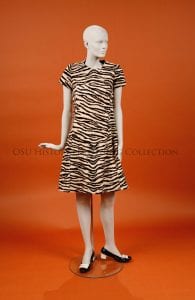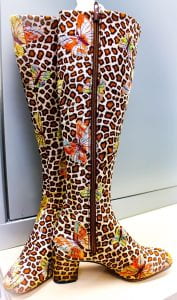Today’s post is all about animal print. It has been a staple in fashion since the early 1930s. However, before it became a fashion statement, it was a sign of power. Kings and Queens owned animal print rugs as a way to show social status, and hunters believed that the animal prints gave them the power of that animal. For example, wearing the skin of a cheetah would give them the speed of that cheetah. Even though people have decided it doesn’t give you power, fashion lovers continue to have a demand for animal print everything.

zebra print suede dress, 1960s
We began to see a rise in the demand for animal prints during the 1930s. One of the biggest movies at the time, Tarzan the Apeman, came out in 1932. MGM’s Johnny Weissmuller as “Tarzan”, and Maureen O’Sullivan as “Jane” wore animal print clothing. It caught the eye of the audience. For them, they saw it as adventurous, exciting, and attractive. Suddenly, manufacturers and designers came out with more and more animal print blouses, scarves, and coats than in previous decades.
The popularity of spotted cat prints grew throughout the 1930s and 1940s, especially those of leopard, ocelot and jaguar. These appeared primarily in the form of fur coats.
In the 1950s Christian Dior created a new line inspired by animal prints, more specifically leopard. His obsession of leopard came from his muse Mitzah Bricard. Dior claimed, “Bricard is one of those people, increasingly rare, who make elegance their sole reason for being.” Dior relied on her for tips to improve outfits by adding accessories or taking pieces away. “From time to time, Madame Bricard emerges from her hatboxes, sails in magnificently, gives one definitely adverse comment, condemns an unfortunate fabric with a look or suddenly plumps for a daring color.” Madame Bricard’s influence on Dior created a whole new era for the animal print. It now became a statement piece for every woman. Beautiful yet chic.

giraffe-print knee-hi boots with applique butterflies, early 1970s
The hippie movement of the 1960s and early 1970s created a whole new world for animal prints. Unlike the chic and sophisticated look of the 1950s, the new style was geared towards “The concept to be wild and free, like an ‘easy rider’.” New colors and patterns such as giraffe and zebra were introduced in garments and accessories.
In the 1970s and 1980s animal prints were everywhere. Jumpsuits, undergarments, shoes, and bell bottoms were all infused with the animal print style. There was an overwhelming amount of animal print, and it came with greater variety. In past decades, it was predominantly about leopard and cheetah “spots”, especially in the days of Dior. However, zebra and snakeskin were now added.

1980s 2-piece dress ensemble
Full dresses, blouses, skirts, shoes, and more were making a statement. Today’s style of animal print is well-rounded. It takes inspiration from all the previous decades in order to make the print classy yet attractive.
SOURCES:
Foreman, Katya. “The Muse: Mitzah Bricard.” Accessed on November 16, 2018. Retrieved from https://wwd.com/business-news/retail/the-muse-mitzah-bricard-505061/
Walker, Alexis. “A Brief History of Animal Prints.” Accessed on November 11, 2018. Retrieved from https://www.nowthatslingerie.com/bradoctor/blog/blog-updates/a-brief-history-of-animal-prints/2011/04/28


That’s interesting how animal prints evolved during these years.
I love animal prints myself and with years my love towards them just grows.